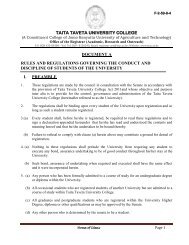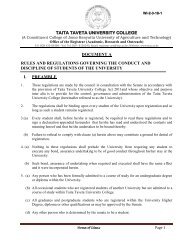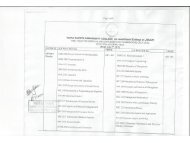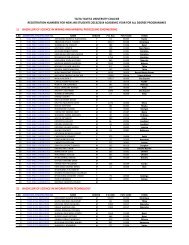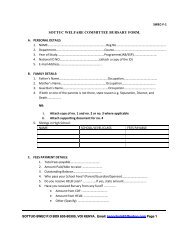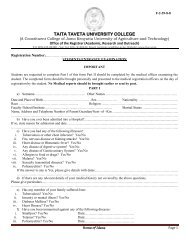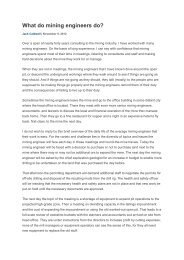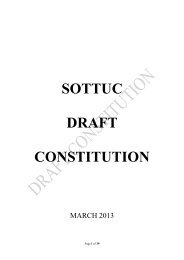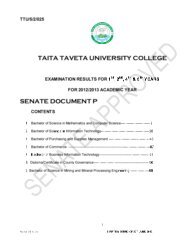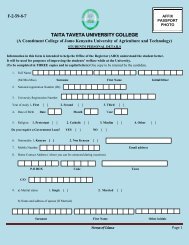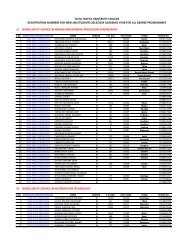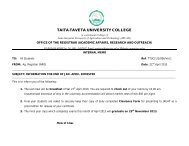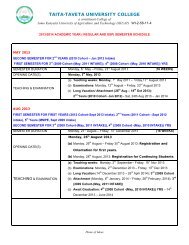Conference Book of Abstracts - Taita Taveta University College
Conference Book of Abstracts - Taita Taveta University College
Conference Book of Abstracts - Taita Taveta University College
- No tags were found...
You also want an ePaper? Increase the reach of your titles
YUMPU automatically turns print PDFs into web optimized ePapers that Google loves.
Klingner, DE (2000). The Role <strong>of</strong> Pr<strong>of</strong>essional Associations in Strengthening the Pr<strong>of</strong>essionalization <strong>of</strong> PublicAdministration. Congreso Internacional del CLAD sobre la Reforma del Estado y de la AdministraciónPública, Santo Domingo, Rep. Dominicana, 24 - 27 Oct. 2000Cryptic termite species diversity in Kakamega Forest, KenyaZipporah B. Osiemo 1, 2* , Andreas Marten 1 , Godfrey H. Kagezi 4 , Johanna P.E.C. Darlington 5 , Manfred Kaib 3 , LinusM . Gitonga 2 , Hamadi I. Boga 6 and Roland Brandl 11 Animal Ecology, Department <strong>of</strong> Animal Ecology, <strong>University</strong> <strong>of</strong> Marburg, Marburg, Germany.2 Department <strong>of</strong> Zoology, Jomo Kenyatta <strong>University</strong> <strong>of</strong> Agriculture & Technology, Nairobi, Kenya.3 Department <strong>of</strong> Animal Physiology, <strong>University</strong> <strong>of</strong> Bayreuth, Bayreuth, Germany.4 Kawanda Agricultural Research Institute, Kampala, Uganda.5 Zoology Department, <strong>University</strong> <strong>of</strong> Cambridge, Cambridge CB2 3EJ, UK.6 Department <strong>of</strong> Botany, Jomo Kenyatta <strong>University</strong> <strong>of</strong> Agriculture & Technology, Nairobi, Kenya.*Corresponding author zbisieri@yahoo.com or zlagat@jkuat.ac.keTermites are among the keystone species <strong>of</strong> tropical ecosystems and contribute to ecosystemprocesses and carbon and nitrogen cycles. The role <strong>of</strong> termites for soil processes dependsstrongly on the species composition and their feeding habits. Termite workers aremorphologically rather uniform, and thus exhibit only few traditional taxonomic characters forspecies identification and yet they dominate in ecological surveys. Therefore, the diversity <strong>of</strong>termites is poorly understood, especially in tropical forests which are hotspots <strong>of</strong> biodiversity andthreatened by disturbances. Recently, the use <strong>of</strong> DNA-sequences (barcoding) has become moreimportant for inventory and biodiversity assessment <strong>of</strong> hyperdiverse taxa and those which aredifficult to identify. An approach towards establishing a DNA barcode library for termite speciesidentification and biodiversity assessment using sequences <strong>of</strong> the mitochondrial COII gene ispresented in this study. Kakamega forest is the remnant <strong>of</strong> the Congo-Guinean Forest reachingKenya. This isolated forest is a hotspot <strong>of</strong> biodiversity which is threatened by the increasinghuman population. Depending on the land use, along a gradient from primary rain forest t<strong>of</strong>armlands, the species composition among the termites varied greatly, dominated by termitespecies feeding on wood in the primary forests and by grass feeding termites in farmlands.Hence, to interpret the role <strong>of</strong> termites in different land-use habitats, the species compositionneeds to be understood. Here we present termite biodiversity assessment using sequences <strong>of</strong> themtCOII gene. 854 sequences <strong>of</strong> a 681bp fragment <strong>of</strong> the COII gene <strong>of</strong> termites were extractedfrom GenBank and used to define molecular thresholds for termite species delimitation by usingmeans, medians and a threshold method.A threshold value <strong>of</strong> 0.058 K2P-sequence divergence per site was calculated for termite speciesdelimitation, using COII sequences <strong>of</strong> termites from GenBank. A family-specific threshold <strong>of</strong>0.056 was calculated to delimit the species for termites from Kakamega forest, all belonging tothe family Termitidae. Morphological assessment <strong>of</strong> 240 samples suggested that at least 16morphospecies occur along the gradient. A sequence-based analysis revealed existence <strong>of</strong> 22



